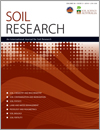SR16343Fabric of soil derived from parna and the riddle of transported pellets
‘Parna’ the clayey loess of southeastern Australia, is assumed to have been transported by wind as fine sand- and silt-sized pellets, but little direct evidence of such pellets has been shown. The micromorphological and granulometric properties of several soils derived from parna have been investigated. In upper (younger) subsoils derived from parna, prolate fine sand-sized pellets are identifiable and have a distinctive mosaic-speckled b-fabric. However, in lower subsoils derived from older parna deposits, abundant illuviation features and a lack of identifiable pellets suggest that weathering and various pedologic processes have destroyed them.




